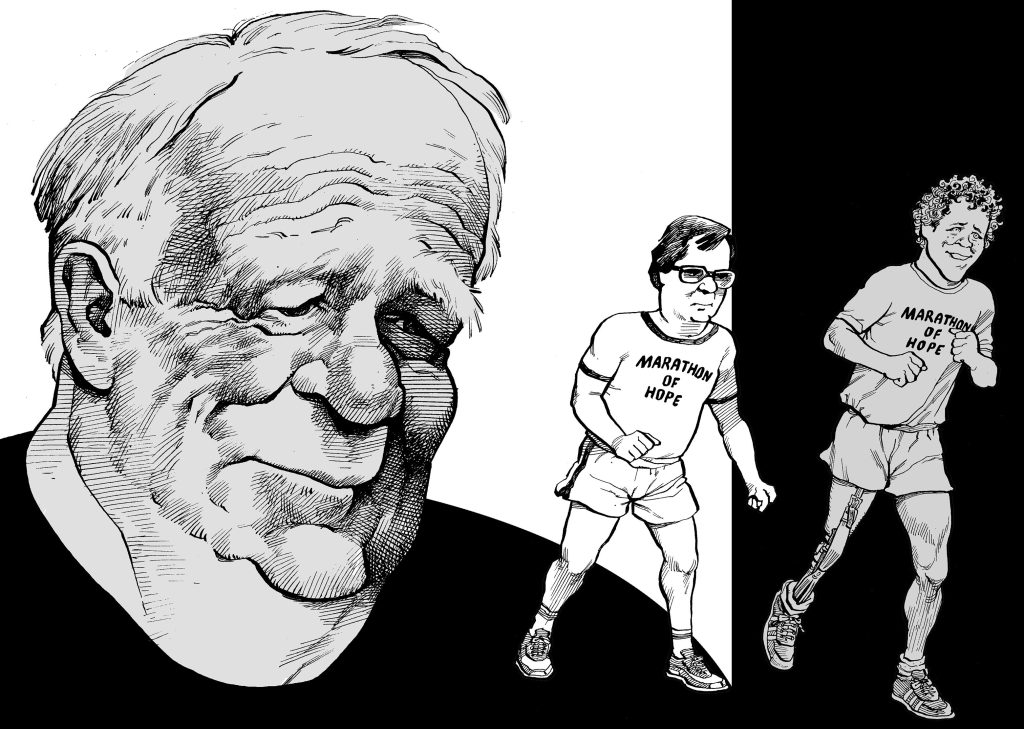Terry Fox requires no introduction. His story inspired the world’s largest annual one day cancer fundraiser — bringing in more than $850 million since 1980 — and he is regularly cited as one of the most admired Canadians. At least ten books have been published and two motion pictures produced about him, and over 9,000 runs are hosted in his name every year. In other words, Canadians already know the lore that surrounds Terry Fox.
In Terry & Me, Bill Vigars — the activist’s friend, publicist, and wagon master on the Marathon of Hope — seeks to bring Terry Fox the icon down to earth, with a more intimate depiction of Fox the person. Vigars contextualizes his memories with details of his own difficult times, including a perfect storm of personal and professional adversity in the late 1970s: a fruitless business venture, a failing marriage, a lost home, and a battle with depression.
When he joined the Canadian Cancer Society’s Ontario division in February 1980, as its director of public relations and fundraising, Vigars expected to help execute the annual daffodil campaign that April. But history had bigger plans for the thirty-two-year-old. “My feelings about Terry hadn’t come out of nowhere,” he writes. “I needed that job with the Canadian Cancer Society and I needed an inspiration like Terry Fox.”

Looking back at an inspiring moment in Canadian history.
David Parkins
Vigars looks back fondly on his time with Fox without mythologizing the young man from British Columbia or putting him on a pedestal. But Vigars does take issue with previous literary and dramatic depictions of Fox as a short-fused and difficult person, repeatedly pointing to his sense of humour instead. “Having an artificial leg has its advantages,” Fox once wrote in his diary. “I’ve broken my right knee several times and it doesn’t hurt a bit.” Whether it’s with memories of starting a cake fight, mooning a group of spectators, or adventures in bilingualism, Vigars treats the reader to more than just the intensity of the marathon and the tragedy of its conclusion. It’s no accident the book’s cover avoids the all too familiar looks of pain, concentration, and determination on Fox’s face — instead presenting readers with a smile.
Vigars, who played a major role in marketing Fox to newsrooms and sponsors across Canada, also offers a credible perspective on the intent of the run, which extended beyond fundraising. Indeed, it was just as much — if not more — about changing the way people perceived cancer. “Terry put a human face on cancer,” Vigars writes. “He brought it home to every person he met — everyone who saw him out there on the road, literally fighting the disease.” Fox and Vigars alike saw cancer as something to be tackled, not feared, and they worked to drive that point home to generations of Canadians, one laborious step at a time.
Like many others, Vigars needed convincing before embracing Fox as the real deal. To help explain his initial skepticism, Vigars points to Harry Crawshaw, supposedly an eighty-year-old cancer survivor who was undertaking a cross-country fundraising trip of his own at the same time, starting from the Pacific coast. There were even discussions of a mid-country “Harry and Terry” meeting. The initial excitement ground to a halt when Crawshaw was spotted loading his bike into a Greyhound bus. Such stories of fraud gave people reason to question the twenty-one-year-old Fox. For his part, Vigars did not take long to overcome any lingering hesitancy; he threw himself into the project, often to the detriment of other responsibilities with his new job. But this singular focus gave him a compelling vantage point on what Fox tried to accomplish — and how he was understood by the general public.
At least some negativity was fuelled by the opinion columnist Doug Collins, “a well-known British Columbia controversialist . . . who would later be exposed as a virulent racist.” In one article, which “cut Terry to the quick,” Collins alleged that Fox simply drove through Quebec — an easily refutable allegation that was eventually retracted. Nonetheless, it was an “unwarranted attack on Terry’s integrity.” Because Fox built so much of his run on its accessibility and transparency, such allegations stuck with and frustrated him. While nobody levelled attacks as vicious as Collins’s, many showed general indifference to Fox’s cause, especially early on. “Quebeckers were friendly enough but when they stopped on the highway, it was usually to offer him a lift,” Vigars recalls of their time in the province. “In one hundred mile stretch of running, he raised only $35.” But Vigars also gives credit where it’s due: “Quebec today is a leading fundraiser for the Terry Fox Foundation. When Quebec schools hold a Terry Fox Run, they raise more money per student than anywhere else in Canada.”
For every Doug Collins, there were several journalists who believed in the Marathon of Hope and, in some cases, went to great lengths to capture it for Canadians. One was Peter Martin, a twenty-three-year-old photographer for the Oakville Journal Record, in Ontario. Martin took a now classic photo of Fox’s unmistakable silhouette in the dark — one that almost did not make it into print. The paper’s editors initially rejected the image because Fox’s face was not visible. Martin was undeterred and sent it to the Canadian Press. Ultimately, it was selected as the wire service’s photo of the year. Vigars uses anecdotes like this to highlight a non-linear success story: Fox overcame initial indifference through persistence, eventually reaching a crescendo of emotions and momentum when running through downtown Toronto past tens of thousands of cheering supporters.
Vigars also goes to great lengths to describe who motivated Fox: the cancer patients he crossed paths with, many of them children and terminally ill. “It shook him up,” Judith Ray, Fox’s nurse at Royal Columbian Hospital in New Westminster, British Columbia, recalled years later. “There were people in the same ward as him who had the same problem as he did, and it was obvious some of them were dying. That reinforced the reality of what he was up against. Even that didn’t depress him. It gave him motivation to really fight, because he saw people there were really suffering.” Fox would regularly visit this group of patients until he began his run. (He died at the Royal Columbian in June 1981.)
On the run itself, Fox met Greg Scott, a ten-year-old baseball player with the same type of bone cancer: osteosarcoma. (Terry had lost his right leg to the disease, and Greg had lost his left.) Greg waited three hours with his family to see Fox in Hamilton, Ontario, and struck up a friendship with him. “The camaraderie between two cancer survivors was palpable,” Vigars recalls. “Everyone standing nearby could feel it. We couldn’t help but be impressed by the sparkle in Greg’s eyes, his admiration for Terry, and Terry’s affection for him.” It would not be the last time Greg connected with Fox on the Marathon of Hope: his parents helped coordinate a rendezvous in northern Ontario, where he accompanied the runner by bike. “Terry marvelled at Greg’s ability on the bike, saying that when he tried to ride a bike in Port Coquitlam his leg kept falling off,” Vigars writes. “It was obviously a very special day for the boy.”
In some ways, the continued celebration of the Marathon of Hope feels at odds with contemporary culture. Many traditional notions of athletic competition — as a battle of willpower versus pain — have been discarded, with more attention paid to the physical and mental health of participants. In that context, it’s hard not to feel conflicted about what Fox endured and the neglected medical appointments along the way. While Vigars shows genuine concern for Fox’s health, he doesn’t spend much time reconsidering the responsibilities of all who lauded the young man’s tenacity. He is clear, however, that Fox was unlikely to be slowed or stopped at any point without a fight. One afternoon in Burlington, Ontario, for example, a woman started yelling from her car, “They’re using you! They’re using you!” Fox, who typically “did not break stride or talk or shake hands or acknowledge the crowds,” stopped and walked up to the driver. “They’re not using me enough,” he calmly and politely told her. The simplicity of that response encapsulates Vigars’s memory of his friend: determined, plain-spoken, pragmatic.
Perhaps it was this direct, unsentimental approach that allowed Fox to power through such an overwhelming physical challenge. As Vigars recalls, he used to tell people, “I am no different than anyone else.” After reading Terry & Me, it’s hard to agree. Although many of us are familiar with the lasting impact of the original run, Vigars delivers valuable insights into those months on the road — the highs, the lows, and, most importantly, the laughs.
Jeff Costen worked for three cabinet ministers in Ontario’s most recent Liberal government. He is now a principal at Navigator Limited.
Related Letters and Responses
Joel Henderson Gatineau, Quebec

